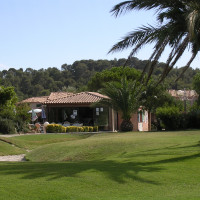The Valcros Golf Course, built on the foothills of the Massif des Maures by architect Frederick William Hawtree, offers an 18-hole, PAR 70 course measuring 5,283 meters. Open since 1964 in La-Londe-Les-Maures, 83 - Var, in the Provence-Alpes-Côte d'Azur region, it is located between Saint-Tropez and Toulon. The course spans 50 hectares of hilly Provençal terrain, featuring narrow and undulating fairways set within a cork oak forest, making it a short and technical course.
On-site amenities include a driving range with 17 mats, 7 of which are covered, extending over 195 meters with distance targets. The pro shop offers balls, apparel, shoes, accessories, and both manual and electric trolleys.
Message from the golf course: If Pete Dye is famous for his use of railroad ties and Trent Jones for "Target Golf" with wide bunkers and vast water hazards, the Hawtree father and son lineage is also recognizable by common details. Setting aside the typically British Links, which have little in common with the physical geography of this course, most of the courses designed or renovated by the Hawtree Family in Inland regions share many similarities.
Respect for the existing environment: A "Hawtree" course is not intended to drastically alter the original terrain where the golf course is built. Bulldozer work is kept to a minimum, large trees are preserved, and the natural course of rivers and streams is respected. A Hawtree course integrates seamlessly with nature without disrupting it. Fontainebleau, Saint-Nom, and Le Vaudreuil are excellent examples of this.
Proximity of greens and tees: Similar to British courses, and when possible, the architect tries to place the tees of the next hole as close as possible to the green of the hole just played. Whether Inland or Links, Hawtree Golf Courses maintain this traditional feature.
Bunkers: The goal is not to punish a player who has made a good shot, but to encourage certain bold moves when trying to cut a dogleg or reach a green in regulation. On a Hawtree course, the number of bunkers is not a point of pride. Instead, one must know the course, as the bunkers are not always obvious. They are more often configured in a pot bunker style than following the model of American architects, with large sandy lips.




































